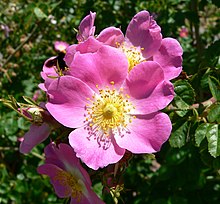Well, flowers are a part of reproduction in angiosperms. Angiosperms use flowers, fruit and pollen to reproduce by doing a process called pollination and fertilization.
Pollination means to move pollen from a stamen of a flower to a pistil of a another flower. Fertilization is giving the egg all it needs to turn into a seed. Gymnosperms use male and female cones and pollen to reproduce. They also use pollination and fertilization.
Pollen is moved to different flowers is by using pollinators. Pollinators are usually small animals for flowers like insects, birds and bats.
They move the pollen by going to a flower for nectar, then the anther of that flower will brush up against the pollinator and will release pollen on to it. It will then go to another flower for more nectar. The stigma of a flower will come and collect the pollen off the pollinator to the flower's egg to become a seed.
The stamen, which is a male reproduction part, holds pollen or male sex cells but the stamen has two sections in it. One is the anther. They're the top part of the stamen and they release the pollen during pollination. The other parts are the filaments and they support the anthers.
The pistil is the female reproduction part and it has four sections. In it, one is the stigma and it collects pollen during pollination with its sticky tip. The second one is the ovary. It holds the flower's eggs for pollination and fertilization.
The third one is the style. It's the tube the pollen goes down to the ovule to turn the flower's egg into a seed. The fourth one is the ovule. It produces the egg in pollination and fertilization.
Three methods of seed dispersal are wind, animals, and water. A lot of plants use wind to move their seeds some where else. Plants also use animals to move their seeds by putting their seeds in fruit, then an animal will come and take it somewhere else. Plants use water to move their seeds some where else.
My favorite flower is the rose. They're 100 species of roses. To protect themselves from small animals, some have small, sharp, thorny prickles.
Most roses are in Asia, but people use roses for different reasons. Roses can be put into jelly, jam and marmalade and is used in skin products. They are also used in vitamin C. Roses can be up to 7 meters tall. The word rose came from the French.
Bye, that's really the end of my blog.





















